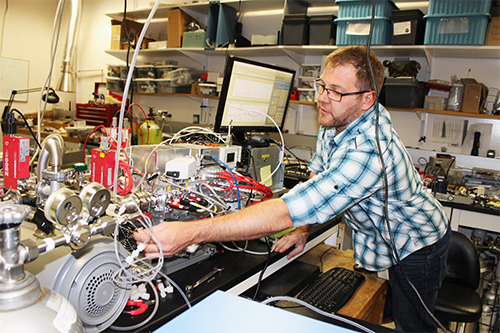A .gov website belongs to an official government organization in the United States.
A lock () or https:// means you've safely connected to the .gov website. Share sensitive information only on official, secure websites.
2 November 2020

Recognized for Personal and Professional Excellence, Patrick Veres receives a 2020 OAR Employee of the Year award for his pioneering work to redefine the atmospheric chemistry of the marine sulfur cycle and its role in Earth's climate system.
Climate models rely on accurate parameterizations of emissions and chemistry of sulfur from the global oceans. To date, these models have incorporated incomplete and inaccurate atmospheric chemistry of the major natural sulfur source, dimethyl sulfide (DMS). In a 2020 Proceedings of the National Academy of Sciences publication earlier this year, Dr. Veres clearly and definitively provides the world's most accurate understanding of DMS oxidation and defines the direction required to fully characterize this important cycle. The discovery was the result of Dr. Veres' extraordinary experimental skill, dedication and insightful analysis. It will undoubtedly lead to new research directions within NOAA and in collaboration with its partners in other agencies and the academic and international research community.
Dr. Veres was particularly interested in a nitrogen compound expected to occur only in the upper atmosphere, just within range of the top altitude sampled by the NASA DC-8. His instrument showed a signal attributable to that compound, but consistently at low attitude, just above the ocean surface, where its presence made no sense. Dr. Veres quickly realized he had observed something completely different, and the definitive attribution of the mystery signal was made possible only by his masterful and pioneering work in preparation for the Atmospheric Tomography Mission (ATom) to make his instrument the most sensitive and accurate in the world. He demonstrated conclusively that the signal arose from a sulfur compound rather than one containing nitrogen, and he further showed that its chemical identity was consistent with a previously unknown pathway in the DMS oxidation cycle. A purely theoretical paper had suggested the potential pathway a few years earlier, but it had received little attention, in part for lack of experimental evidence. Dr. Veres now had the smoking gun. A large fraction – approximately one third by current estimates – of the DMS oxidation cycle went through this newly discovered compound, hydroperoxy methylthioformate (HPMTF).

Not only was this previously unknown compound responsible for a large fraction of the natural sulfur budget, but the field data clearly showed that it interacted strongly with marine clouds, such that its fate and atmospheric chemistry would be complicated and potentially extremely important to climate. Dr. Veres led a team of over 40 authors in a comprehensive publication to describe the instrument, the field data and their analysis, the supporting laboratory measurements, and initial modeling detailing the significance of the discovery. It remains to be determined where this discovery will lead, but one thing is certain: we will have an entirely different understanding of a major component of the Earth’s climate system after 2020 as a result of Dr. Veres' work.
Dr. Veres has quickly capitalized on this discovery and has engaged in the next phase of this research. He is currently directing laboratory work that is key to a theoretical understanding of the discovery he made during ATom, provides analytical calibrations for HPMTF, and will serve to quantify the yield and the subsequent fate of this important compound.